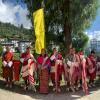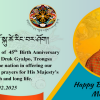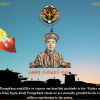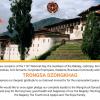About District
Vision: "Socioeconomically vibrant Dzongkhag, rich cultural heritage and living in harmony with nature"
Mission:
Provide a conducive environment for the diversified economic activities for the wellbeing of the people of the Dzongkhag
Introduction
As the vision of the Dzongkhag states “Socioeconomically vibrant Dzongkhag, rich cultural heritage and living in harmony with nature”, every individual under Trongsa Dzongkhag Administration works hard with great endurance and dedication to achieve the vision within a short span of time by achieving plan target percent providing service to all state holders. We are happy to bring this Website forward to all our staff and officials who will be visiting our Dzongkhag Website.
Although the information given in this Website is in nutshell, the Dzongkhag deeply hopes that it will benefit our visitors and high dignitaries in getting overview of the Trongsa Dzongkhag.
Brief History of Trongsa
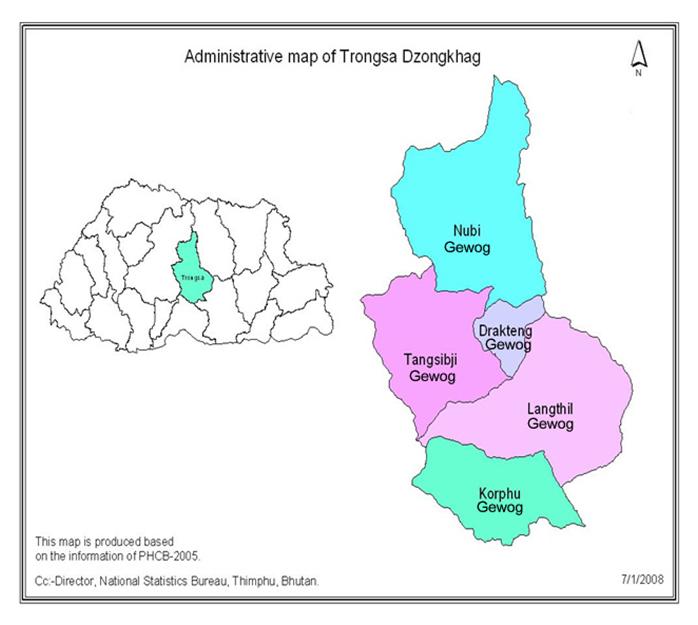
Yongzin Ngagi Wangchuk who was guided, in a vision, by the guardian deity, Palden Lhamo, to go to a place in the central Bhutan, arrived in Trongsa in 1541, and stayed in Yueling. One night, while Yongzin Ngagi Wangchuk was meditating, his attention was drawn by a flicker of light, resembling that of butter lamp burning in the open air, at the spot where the present day Goenkhang of the Trongsa Dzong is located. In 1543, he established a small Tshamkhang (meditation quarter) in the sacred spot and meditated there. He soon attracted a host of disciples who built their own meditation unit around the main Tshamkhang. The cluster of newly built meditation quarters appeared to the people of Yueling like a new village and hence they called it “Trongsa” meaning “new village”.
In 1647, Chhoeje Minjur Tenpa was appointed by Zhabdrung Ngawang Namgyal as the first Trongsa Penlop. On the instruction of the Zhabdrung he constructed the Dzong which resembled a fort and housed various lhakhangs. He also built present Goenkhang on the same spot where Yongzin Ngagi Wangchuk saw his vision. The Dzong was named Druk Minjur Choekhor Rabten Tse which translated into “the Dzong, built on the tip of Dungkar (conch) of the never changing country of Druk where the darma is ever lasting”.
At the end of 17th century Desi Tenzin Rabgay expanded the Dzong. At present the Dzong host Dratshang Rabdey and the Dzongkhag Administration. There are 26 lhakhangs in the Dzong with 450 monks residing in it.
Historically, Trongsa is one of the most important Dzongkhags. Trongsa Dzong had been the head quarter for eastern region and has been the seat of Trongsa Penlop. Even today, the formal investiture of the crown Prince of Bhutan as the Trongsa Penlop is observed in this Dzong.
There are sacred monuments like tapering rock in Nabji lakhang, Kubdra,Ugen Drak and Phumzur lhakhang, which are all believed that Guru Padmasambhava had visited and meditated in this sacred sites on his way back from Bumthang to India in the 8thcentury. Very few people visit these sacred sites because of inadequate road facilities.
The other sacred spots in Trongsa are Ta-Dzong and Trongsa Dzong that lulls immense attraction of tourist.
Trongsa Dzongkhag is located in the heart of the country. It covers an area of about 1807 km², with elevation ranging from 800 meters to 4,800 meters above sea level with a total population of 15562 as of July 2012. It shares boundaries with Bumthang Dzongkhag to the northeast, Wangdiphodrang Dzongkhag to the west and Zhemgang Dzongkhag to the south.
Despite formidable rugged terrain in most parts of the Dzongkhag, the black topped East-West highway and the Trongsa-Gelephu highway passes through the Dzongkhag connecting almost all the gewogs, which serves as the main economic artery.
Though the East-West and Trongsa-Gelephu highway passes through the Dzongkhag, most settlements are scattered and still remote due to lack of feeder roads. This combined with the rugged terrain makes delivery of services difficult and costly. Still, every Gewog in the Dzongkhag has a BHU, RNR centers and a School each providing basic services. It is further supplemented by extended classrooms and Out Reach Clinics.
Trongsa Dzongkhag consists of five gewogs namely, i. Drakteng covering 84.8 km², ii. Korphu 288.1 km2 iii. Nubi with 554.4 km², iv. Langthil with 508.4 km² and v. Tangsibji with 371.6 km², Nubi Gewog is the most densely populated gewog of the Dzongkhag. Agriculture farming is the main source of income for majority of the population. Farmers grow almost all kinds of crops but in some areas potatoes are the main source of cash income.
Jigme Singye Wangchuck National Park that covers an area of 1723 km² is a home for many globally endangered rare flora and fauna, and it’s a habitat for one of the most globally endangered species, Golden Langur. The Park was gazetted in 2000, in order to protect large area of virtually untouched ecosystem, ranging from mixed conifer in the north to chir pine / broadleaf forest in the south. The Monpa the earliest habitants reside on the lower parts of the Jigme Singye Wangchuck National Park.
The Mangduechhu River flows through the heart of the Dzongkhag dividing the Dzongkhag almost into two halves. The Dzongkhag enjoys a mixed climate, that is, warm humid and warm temperate with soil type of sandy loam and clayey loam. The topography is rugged with deep gorges to the north and steep slope in the south.
87.15% from the total of 1587 Km2 of Trongsa Dzongkhag is under forest cover.
The Mangdechhu Hydroelectric project (720 MW) is one among the ten Hydroelectric Projects planned under the 10,000MW Hydropower Development by the year 2020 Programme of the Royal Government of Bhutan supported by Government of India. The Project is located in the left bank of Mangdechhu River. The Project started on 27thAugust 2010 and is estimated to be completed by mid July 2018.
